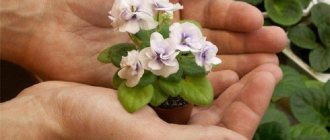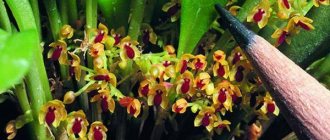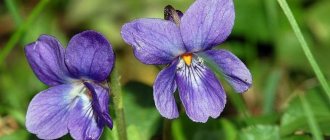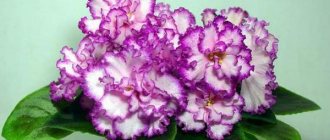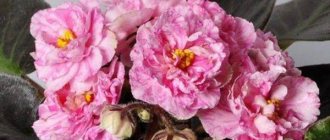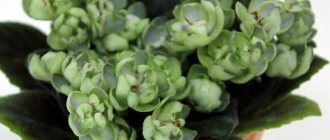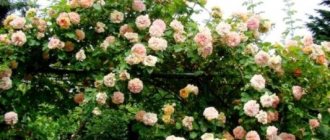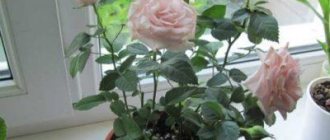Indoor violet or Saintpaulia is grown by most home gardening enthusiasts. When they first began to study this amazing plant, its species forms numbered about two dozen.
Now there are, according to some sources, 500 or even more,
differing in:
- Color;
- Leaf shape;
- Sizes;
- And even a variety of inflorescences.
The structure and shape of a flower from the classic one can be:
- Terry;
- Or fringed.
Even the color scheme is so diverse that it can combine many different shades.
Each variety or species is unique and beautiful in its own way, and one of these miracles is the non-standard variety “Cinderella’s Dream”, with an atypical color for Saintpaulia . It is the non-standard and atypical colors that make it a separate variety.
Violet Cinderella's dream (A. Deykun)
Beautiful violet Cinderella's dream.
History and author of the flower
All types of violets are divided into three large groups:
- Wild;
- Garden;
- Indoor.
“Cinderella’s Dream” refers to indoor, Uzambara violets or, as they are also called, Saintpaulias. In turn, Saintpaulias are classified into types:
- Collection or exhibition;
- Variegated;
- With fantasy coloring;
- Ampelous;
- Industrial;
- Miniature.
A large group of indoor violets can differ in:
- Size;
- Flower shapes;
- Their quantity;
- And the color scheme of the petals.
Even one variety can belong to a number of groups at once.
For information! This is a very old variety of violet of Russian selection - Retro variety, selection by A.V. Deykuna, under registration number 246.
What is the atypicality of the variety?
The atypicality and difference of the variety from many others lies in:
- A peculiar pattern on the petals;
- And their special shape.
Collectors are especially proud of the color variability of this variety , which can change not only depending on the conditions of detention, but also generally have different color options.
Photo and description of the variety
This Saintpaulia has an amazing color.
One of the surprising differences of the variety is the interesting shape of the flowers with a rather unique color. A special aesthetic is represented by semi-double corrugated petals, the upper area of which is decorated with a concentrated mesh of lilac-strawberry color.
When blooming, the flower is completely white and only later acquires a certain unusual color and pattern.
A rather large cap of white-cream, violet-like Anyutka, decorated with :
- Strawberry ruffle and mesh;
- And under certain growing conditions with greenish-brown fringe, they make a unique impression.
There are a number of color versions:
White-pink color may occur.
Purple-white color is also found.
The shiny foliage looks very impressive, with an impressive red underside . The leaf blades are relatively large and wavy. The rosette is standard, but under certain growing conditions it may not be very spreading or even compact.
Sports
Sport violets are Saintpaulias that have undergone a genetic mutation. They are not amenable to varietal propagation . They delight flower growers with their beauty, an unusual combination of colors that can be admired forever.
Various sports may appear in this variety.
And many more different color options.
Mystical black violets - do they exist? TOP 10 varieties of dark color
Sorry to disappoint you, but black violets do not exist in nature.
In the article we have prepared the TOP 10 popular varieties of dark violets of foreign and domestic selection, as well as a photo selection of varieties with darker flowers. Look and enjoy their beauty! The darkest colors of flowers always attract attention , sometimes even from people who are indifferent to this flower, and violets are no exception.
The dark tones of these flowers are combined with the beautiful shape of the flower, as well as the color and shape of the leaves. The resulting composition is mesmerizing.
Many flower growers, having once seen this beauty, can no longer throw out the thought of purchasing these varieties, despite the fact that there are not so many of them, they are in good demand .
Caring for a plant at home
Lighting and temperature
Many lovers of home floriculture are afraid to grow Saintpaulia, citing the capriciousness of the plant. But it is not so. Indoor violets are not so demanding on growing conditions and care; you just need to follow simple growing rules.
The amount of daylight or lighting required is quite large:
- 14-16 hours in the summer;
- And 10-12 hours in the winter season.
is not allowed on the plant:
- Direct sunlight;
- And the touch of leaves on the glass.
This may lead to:
- Burn like flowers with leaves;
- So and overheating of the root system.
If there is insufficient lighting, additional lighting can be used using phytolamps.
Bright, sufficient lighting promotes lush and long-lasting flowering . And the lack of this forms a spreading, shapeless rosette, with elongated leaf petioles and a reduction in the formation of buds.
Attention! Careful adherence to temperature conditions is required.
Too high temperature and cold in the room are detrimental to this variety . The optimal temperature can be considered:
- From 20°C to 25°C in summer;
- And not lower than 18°C in winter.
Effect of air humidity
Violet prefers air humidity in the range of 50-60%.
Typically, the humidity in modern apartments corresponds to growing requirements . Maintaining humidity at a level of 50-60% is considered the best option. The air in the growing area should always be fresh, which is ensured by regular ventilation, avoiding drafts.
High humidity promotes the development of various types of fungal diseases, and excessive dryness does not allow the plant to fully function .
Features of watering and fertilizing
Excessive watering, as well as drying out the soil, is detrimental to any type of violet. In this regard, an important component of plant care is proper organization of watering. The soil should always be slightly moist.
Additional watering is carried out only when a third of the top layer is completely dry.
According to the recommendations of experienced gardeners, one of the best watering options is the wick method , which allows the plant to independently control the amount of necessary moisture in the soil.
The supply of moisture to the soil is achieved using a synthetic cord - a wick, the size and thickness of which is selected depending on the size of the flower pot. Typically, the cross-section of such a wick is from 0.3 to 0.5 cm.
Important! Wick watering requires a certain looseness of the soil, which is achieved by the presence of perlite and vermiculite in the composition.
In order for the “Cinderella’s Dream” violet to develop well, grow and bloom profusely, it must have enough certain nutrients in the soil . Over time, the soil is depleted and the plant lacks essential substances, micro- and macroelements. Therefore, it is necessary to periodically add additional nutrition.
The composition of fertilizers, their quantity and frequency depend on the time of year , stage of development and growing conditions. On average, using the advice of experienced violet growers, fertilization is carried out according to the following schedule:
- In winter, 1 fertilizing with organic fertilizers;
- In the spring of the year and the beginning of the summer season, mineral-based fertilizing is done every 14-21 days;
- In summer, feeding is carried out only in cases of depression.
For good growth, violets must be fed with fertilizers.
What soils are preferable for growing at home?
Saintpaulia "Cinderella's Dream" needs light and loose soil that provides good moisture and breathability. The optimal composition is considered :
- 5 parts of a mixture of leaf and turf soil;
- 3 parts of high peat;
- 1 part river sand;
- 10-15% of the resulting volume of vermiculite.
Many gardeners use purchased ready-made soil . But, to improve breathability and looseness, you should add to it:
- Vermiculite;
- Or perlite.
Pruning and hygiene
With age, the lower leaves:
- Getting old;
- Fade;
- And they turn yellow.
Therefore, periodically, when such a phenomenon occurs, in order not to spoil the aesthetic appearance of the plant, they are pruned.
Attention! No special hygiene procedures are required.
Rules for transplantation and rejuvenation
An important task for an amateur gardener is recognizing the need for replanting , since the soil not only loses its nutritional properties, but also cakes, leaving the plant without food and air. Also a factor in transplantation is the growth of violets, which provokes:
- Replacement of container;
- And exposure of the lower part of the trunk.
The best option for such a procedure would be spring or autumn . Also, annual replanting will provide the plant with the necessary nutrients for complete:
- Development;
- Growth;
- And harmonious flowering.
Saintpaulia needs to be replanted once a year.
any special requirements for replanting . The rules are the same for almost all types of Saintpaulia.
Flowering occurs only after the root system has developed the entire volume of soil. using a large container
Advice! You need to know that the diameter of the container should not exceed 12 cm.
Rejuvenation is carried out when an aged violet, as the lower leaves age, takes the shape of a palm tree . If you leave it in this state, then:
- Flowering will noticeably weaken;
- Leaves and flowers are crushed, losing their original shape.
There are two main methods of rejuvenation :
- Recess;
- And rooting.
Which one should I use? At the discretion of the grower, depending on the growth of the bare trunk.
Felt cherry Alice: description of the variety
Cherry Alice grows no more than 140-160 centimeters in height; the cherry bush turns out to be very dense, with practically no free space. The bush has an oval shape and grows at an average speed. The branches are usually brown-gray in color, they are covered with small tubercles, which are also called lentils. The branches themselves are strong, wide, and they develop evenly. The shoot is quite long and colored in an even brown-beige color; there is a small fluff on the shoots.
The bush has buds, but they are small in size, slightly fluffy and resemble the shape of a carrot, as they have a sharp end. Alice's foliage is a very rich green color; the leaf looks like an elongated oval with a sharp side. The leaves have irregularities and teeth along the edge of the leaf blade, and there is a slight fluff.
Cherry petioles are also fluffy and short, up to 50 millimeters, and have an average width.
The cherry flower is of medium size, usually it is not larger than 25 millimeters, the shade can be white, or maybe pink, and it resembles a ball in shape.
Note: This variety is highly resistant to drought.
The fruits of this variety are very large, so it belongs to large-fruited varieties, each berry can weigh about 4 grams, inside the berry there is a seed, which, even when the Alice cherry is ripe, is difficult to separate from the berry. The fruit looks like an elongated circle with a sharp end. The skin is very thin and practically does not protect the flesh from injury; it is burgundy in color. The fruit inside is very juicy, pinkish-red in color. With good care, cherries can bear fruit without interruption for about 20 years.
Initially, this variety was created for cultivation from the area where it was created. But over time, it began to gain popularity and spread to other areas. After it took root in different territories, it began to be actively grown on an ongoing basis.
Features of flowering, growth and reproduction
How does it develop at home?
Growth and development at home is quite normal, subject to the usual and simple rules of care .
A sufficient amount of lighting, temperature, proper watering - these are all the requirements for the plant to develop successfully and delight the grower with harmonious flowering.
According to experienced violet growers, this variety is unpretentious and absolutely not difficult to grow.
How long does it take to grow an adult plant?
Approximate time of plant formation when propagated by leaves:
- It takes about a month for the roots to emerge from the leaf;
- It takes 1-1.5 months for babies to appear;
- Up to 3 months before the phase of separation of the children from the mother plant;
- Up to 9 months for the first flowering of a young plant.
This variety grows in 1.5-2 years.
It must be taken into account that the first flowering is not full . On average, it takes from 1.5 to 2 years for a violet to “mature”, with proper care.
Reproduction methods
“Cinderella’s Dream” can be propagated vegetatively:
- Rooting the leaf;
- Or stepchildren.
Rooting with leaf cuttings
A completely healthy leaf, free of flaws and spots, occupying the 2nd row of the rosette , is cut off and placed petially in a container with warm and clean water.
When roots up to 1.5 cm in size appear on it, it is transplanted into a glass containing a composition of soil and sand in a ratio of 1 to 1.
It is in this container that the leaf takes root before the first babies appear - about a month.
Important! When the children develop leaves with a diameter of about 3 cm, they are separated and transplanted into separate containers.
Rooting by stepsons
The stepchildren are disconnected from the mother plant using tweezers or an awl , and then planted in a sand-soil mixture. Moreover, each of the stepsons must have 3 or 4 full-fledged leaves and roots.
Important! Reproduction by stepsons practically preserves the varietal characteristics of the parent. Moreover, such a plant blooms earlier than when the leaf is rooted
.
Sometimes you can take a stepson to propagate violets.
Flowering options
flowering variations for collectors
- A white flower with a mesh and strawberry-colored ruffle on the two upper petals;
- A white flower with a mesh and strawberry-colored ruffle on all petals;
- And the most striking option, memorable for its variably white flowers with strawberry ruffle and mesh on all petals.
The greenish tint of the fringe appears when the growing temperature is below optimal.
Attention! It is this variability that is of particular value and uniqueness for collectors.
Standard flower size, number of buds on a peduncle
The size of the flowers is not considered very large. Average size is about 4 cm . There are usually about 6 buds on a peduncle, but there are many peduncles, so the flowering plant looks like it has cap blooms.
According to some gardeners, the flower stalks are too long, which does not look very aesthetically pleasing. But the length of the peduncle depends on the amount of lighting.
With enough light, the peduncles are of normal length, standard for violets.
Is it possible to achieve cap flowering?
Bouquet flowering is almost constant . The first flowering begins with 2-3 peduncles, but after 2-3 flowerings a cap flowering appears and forms.
Bud lifespan
If the temperature is not hot and there is sufficient nutrition, flowering lasts about a month . Frequent flowering, with a large number of peduncles, is one of the advantages of the variety.
One flower can bloom for up to 9 days.
Of the minor shortcomings, you can o . But there are not so many of them, and they stay on the peduncle for quite a long time (up to 7-9 days). This usually does not prevent cap flowering.
Effect of lack of lighting
A sufficient amount of daylight is half the success when growing violets at home. Violet leaves are adapted in such a way that they catch a certain spectrum of light, which has a significant impact on the synthesis of organic substances in the plant.
Lack of lighting causes:
- Slow growth;
- Premature drying of buds;
- And not forming new ones.
The flower stalks will stretch towards the light and turn out to be quite long and spreading, which will significantly spoil the picture of the cap flowering.
Effect of cool temperature
A slightly lower than optimal temperature during the flowering period ensures its duration. You can also notice at this temperature the appearance of fringe with a greenish tint on the petals.
Product description
Black cherry. Received N.P. Vishnevetsky in 2005 as a result of pollination of the ZOS-1 variety with a mixture of Nadezhda AZOS + Valek + Richelieu + Kuban pollen. Hybrid form of ultra early ripening (90-100 days). The harvest fully ripens a week earlier than many extra-early varieties. The bushes are vigorous. The Black Cherry grape variety is capable of forming a second harvest on its stepsons, and the quality indicators of the berries increase. The flowers are bisexual. The clusters are large, long, loose or medium loose, with an average weight of 500 g (up to 1 kg). The berries are large, oval or ovoid, black in color, measuring 22 x 30-36 mm, weighing 7-10 g, with small rudimentary seeds. The pulp is fleshy, dense, juicy, very sweet, with a pleasant light taste of overripe cherries, or mulberry-cherry taste, practically no sourness. When overripe, it acquires a wine taste and high sugar, which allows it to be used for making wine. The peel is not felt when eating. The berries practically do not crack, do not fall off, are firmly held on the ridge, and are not affected by wasps and sparrows. The variety is resistant to diseases. Frost resistance is being studied. As the supply of perennial wood increases, the size of the bunch and berries increases.
Hybrids created by the talented Ukrainian breeder Nikolai Petrovich Vishnevetsky are popular among winegrowers. Over the years of painstaking work, he has developed many varieties of grapes, all of which grow well in the unstable climate of Ukraine. The goal of his work was to obtain a high-yielding hybrid with a long shelf life.
Reviews
Natalia. “The opinion of some flower growers about violets in general is interesting. Especially regarding terry types, they are the best. I strongly disagree with this. “Cinderella’s Dream” is such a beautiful and wonderful violet, which also does not require special care or conditions. I have been propagating it beautifully for several years now. I have put together a wonderful collection of different shades. And what kind of abundant and harmonious flowering does it have? All the flowers are one to one, with fringe, translucent under the light of the lamp. Wonderful variety."
Many gardeners are attracted by the color of the variety.
Anastasia. “A neat, beautiful, romantic, fairy-tale-like variety. I bought it at a flower show a couple of years ago and am not at all happy with it. The corrugated flowers are so delicate and numerous that they create coziness in the house for a very long time in the form of a huge hat.”
Marina Dyagileva. “For many years I have been trying to grow Cinderella’s Dream, but I just can’t create the conditions in my essentially cool house. I tried to grow it several times, but when I acquire babies, I just can’t get them to bloom. What am I doing wrong? Or are the conditions in the house not allowing you to achieve a positive result? But I still try all the time.”
Morev’s masterpiece – violet variety “Frosty Cherry”
There are a great many varieties of violets. This flower has long been a leader among garden crops, and today it occupies one of the first places among indoor plants.
And this is understandable - violet flowers are very beautiful. However, in order for them to bloom and delight you with their brightness and unusual shape, you need to know how to properly care for them. This is especially true for breeding species, which include the “Frosty Cherry” violet, which is very popular among violet lovers.
The author and creator of this wonderful variety is breeder Konstantin Morev. “Frosty cherry” is not the only variety whose appearance we owe to this breeder. However, he worked for almost eleven years to create this variety with cherry-colored petals.
The Frost Cherry variety is quite demanding and requires appropriate care. However, thanks to the charm of the flower, the difficulty of caring for it does not frighten gardeners. If you follow the rules of care, the “Frosty Cherry” violet will thank its owners with abundant and long-lasting flowering.
Violet “Frosty Cherry” photo:
Diseases and pests
What conditions contribute to the emergence and spread of diseases?
The development of fungal diseases causes:
- High indoor humidity;
- And excessive watering.
A big factor in the emergence of various kinds of diseases is a decrease in temperature coupled with high humidity. Hot weather can also cause fungal or bacterial diseases.
Important! Failure to follow the rules of care and failure to create acceptable growing conditions contributes to a decrease in violet immunity, which makes it vulnerable to many diseases.
Common diseases include:
- Fusarium - develops with sudden temperature fluctuations and watering with cold water;
- Powdery mildew – high humidity and low temperature;
- Late blight - waterlogging of the soil and lack of lighting;
- Gray rot is the ingress of water onto parts of the plant during watering.
Prevention measures
Any disease can be practically cured in its early stages . First of all, after the first, initial signs appear, the violet needs to be freed from the affected parts and foci of infection.
Any disease of violets can be cured in the early stages.
Then transplant it into new, safe, high-quality soil, with the obligatory replacement of the container. During the transplantation process, it must be treated with fungicides. The most common drugs against fungal diseases on violets are:
- Fundazol;
- Oksikhom;
- And Topaz.
Attention! Experienced gardeners often use Bordeaux mixture for treatment and prevention.
Well, almost black violet Dark Night of The Soul
Speaking of almost black varieties, it is impossible to ignore the Dark Night of The Soul variety.
A beautiful, even, symmetrical rosette, semi-miniature in size, which forms independently. The leaves are variegated, rounded, and quite large. A special feature of the variety are spoon-shaped leaves, the edges curl slightly upward. The color of the leaves is variegated, medium green with white.
The flowers are wine-black, double pansies with a coral-red underside. In bud, the half-opened flower is almost black, but as it opens it acquires a red, rather beet-like, hue.
Important! This variety is the only one bred by McDonald outside the Mac's series.
